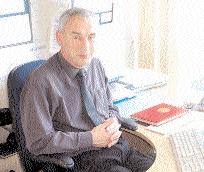
40 minute read
News
petrol from a car belonging to a member of his family, which was parked on his drive in Alfriston Avenue, North Harrow.
Police said he was using a pump which created a spark which ignited fumes, setting him and the car alight. Relatives and neighbours rushed to his aid and managed to put out the flames, although the car continued to burn, and called police, firefighters and an ambulance.
Advertisement
Firefighters from Harrow Fire Station extinguished the burning car and administered first aid while they waited for the ambulance. The man was taken to Northwick Park Hospital with serious burns all over his body and later transferred to a specialist burns unit in Essex.
Chief Superintendent Alex Fish of Harrow police said: "This was a very tragic accident, no-one else was involved. The man is in a very critical condition with 95 per cent burns, and our thoughts go out to him and his family."
UK, December 3 2003 Northamptonshire County Council Concerns over the sale of petrol to under 16s
Investigations carried out by Northamptonshire County Council trading standards officers have found some petrol stations are willing to sell petrol to under-16s.
Officers carried out test purchases with a 13-year-old boy who visited six petrol stations in Corby.
The boy took with him an approved petrol container and on three occasions he was authorised to buy petrol. The legal age for buying petrol is 16-yearsold.
Trading standards officers carried out investigations in response to a problem with arson attacks in Corby and the possibility that in some cases petrol may have been used.
Cabinet member responsible for trading standards Councillor James Ashton said: "Petrol is very dangerous in the wrong hands and it's a great worry that a 13-year-old boy was allowed to buy it. "All staff at petrol stations must know the law and ensure that they check the age of anyone wanting to buy the petrol if they have any doubts."
Written cautions have been issued to the three petrol stations and their head offices and exercises will be repeated in the future.
Assistant divisional officer Chris Lowe, head of community fire safety, said: "If young people are able to purchase petrol this easily it can only increase the dangers not only to their community as a whole, but in particular to the young persons using it. "Petrol stations are licensed to sell petrol and in the cases reported, are clearly breaking the strict conditions of these licenses. If petrol station staff have any doubts regarding the customer's age, and proof cannot be provided, then they should refuse to sell to them. I would ask them to be extra vigilant particularly in the case of self service where age should be verified before filling commences. "Northamptonshire Fire & Rescue Service Petroleum inspectors will continue to work in partnership with the county council's trading standards officers to monitor the situation."
Ammanford, November 27 2003 Petrol mistake kills man and daughter
A father who died with his young daughter in a house blaze after he used petrol to light a fire, an inquest has heard. Neath Cororner's Court heard how Glanville Philip Nolan, 36, made a "valiant" attempt to save his 11-year-old daughter Ella Louise when fire tore through their home Gwaun-CaeGurwen near Ammanford, in June 2003.
The bodies of father and daughter were found next to each other at the doorway of the upstairs bathroom. Ella's mother Jayne Nolan, 30, told the hearing on Thursday that she had been ironing in the back room of their home when her husband rushed from the living room with a "look of horror" on his face. She had earlier asked him to make the fire because Ella had complained of feeling chilly even though it was a bright, if breezy, summer's morning.
Mrs Nolan said the bottom of her husband's jeans were alight and they ran into the front garden but soon realised that Ella, Mr Nolan's adopted child, was still inside. He ran through the smoke and poison gases up the stairs while Mrs Nolan ran round to the back garden where she saw her daughter at the bathroom window. "I screamed to her to open the window," she said, but that was the last she saw of her daughter. Members of her family broke down and wept as Mrs Nolan spoke at Thursday's inquest.
Fire investigation expert John Fitzjohn of Mid and West Fire Brigade said he found it "difficult to comprehend" that two people had died in a fire during the day in a house where people had been "awake and busy." He said the "unusually rapid fire had been helped by the use of petrol."
A petrol can - which was still wet around the cap - was later found in the garden shed. Mr Nolan had planned to use the petrol to destroy an ants nest in the garden. Mr Fitzjohn said that it was likely that Mr Nolan had put an unknown quantity of petrol onto the unlit fire before returning the fuel can to the shed. He had then tried to light the fire with his lighter which was later found in the ashes.
But Mr Nolan had probably not realised the danger of petrol vapour moving with the light breeze when doors were opened in the house. Mr Fitzjohn said, "after he went out of doors the petrol vapour spread throughout the living room. The breeze was moving the vapour around the home. When Mr Nolan activated the lighter he lit the vapour."
Recording verdicts of accidental death, Coroner Dr David Osbourne said it was a tragic accident which highlighted the danger of using petrol outdoors and indoors.
Scotland, 30 October 2003 Petrol Tanker Blaze
Emergency services from across Central Scotland rushed to Kinrossshire this afternoon after a petrol tanker caught fire on a busy route.
The accident happened at 12.15 on the A977, a mile west of the village of Crook of Devon, sparking an operation involving over a dozen fire, ambulance and police vehicles.
It was unclear in the early stages the extent of any injuries, as fierce flames from burning vehicles hindered the operation.
The tanker was carrying 18,000 litres of diesel and 20,000 litres of petrol. There were unconfirmed reports the tanker had been involved in a collision with a lorry.
The road was closed as firefighters from Kinross, Perth, Dundee and elsewhere battled the blaze.
Six units, including the foam tender from Dundee, were called into operation, while ambulance crews also attended, along with the special operations unit and scene managers. The Fire Brigade set up a 200m exclusion zone around the scene of the accident, and nearby houses were
doused to prevent them from igniting.
Around 40 people were evacuated as a precautionary measure, while others further from the fire were told to stay indoors.
Police set up diversions from the road — a busy thoroughfare between the Kincardine Bridge and M90, often used by heavy goods vehicles.
Scotland, October 31 2003 Village evacuated as petrol tanker explodes in massive fireball
Villagers narrowly escaped disaster yesterday when a fuel tanker exploded in a massive fireball seen up to 10 miles away. Residents were evacuated after the main street turned into a 300-yard river of fire and power lines were burned down.
The incident happened shortly after midday on the A977 Kincardine-Kinross road when a tanker carrying 18,000 litres of diesel and 20,000 litres of petrol travelling through Drum, four miles from Kinross, was in collision with a 40-ton low-loader lorry, which was turning out of a junction and carrying a JCB. The tanker overturned and burst into flames.
David Stevenson, 57, a retired engineer, said, "there was a massive explosion and when I opened my door all I could see was thick, black smoke. It was so thick I could not even see the lorry or the flames. When the smoke thinned a little, I saw a tanker lying on its side, burning away. The fuel was spilling out down the street, which had been turned into a river of flames. It was about 400 yards long and the flames were at least three feet high."
Jean Jackson, 57, a retired chief Wren in the Royal Navy, said, "I heard this loud bang and initially I thought it was my washing machine. But then I realised the noise was coming from outside. There were a series of half a dozen louder bangs and then I saw the thick black smoke, and I called the fire brigade straight away."
More than 40 residents and the village primary school were evacuated and a nearby cottage was doused with water to stop the fire spreading. The driver of the tanker managed to crawl out of his vehicle before it exploded. The lorry driver and a passenger also escaped from their vehicle. All three were treated for minor injuries in hospital.
Jack Hutcheon, deputy firemaster of Tayside fire brigade, said, "the tanker was nearly full with fuel and it took us over three hours to extinguish the fire. There was a fire running 300 metres down the road where the fuel had run. The fuel had also run into the drains." The Shell oil tanker had just left the Grangemouth refinery.
Scotland, November 7 2003 Code on protection of groundwater from underground storage tanks
The Scottish Executive has published guidance on protection of groundwater from underground storage tanks (USTs), in terms of the Groundwater Regulations 1998.
The purpose of the Code of Practice is to minimise the potential for UST facilities to result in a detrimental impact on groundwater and other associated receptors, primarily through preventing and containing any loss of product. The publication is relevant to any facility which stores petroleum hydrocarbons in USTs, or distributes such in buried pipelines and it outlines good operational and management practices which should be adopted by UST facilities. Underground Storage Tanks for Liquid Hydrocarbons Code of Practice for the Owners and Operators of Underground Storage Tanks (and Pipelines) can be accessed from the website of the Scottish Executive, www.scotland.gov.uk
Northern Ireland, October 28 2003 Customs clamping down on illegal fuel
Haulage companies are facing fines of hundreds of thousands of pounds for using illegal diesel. At least two companies from Northern Ireland are being investigated and could face penalties of more than £250,000, according to a senior Customs officer. Colm McAllister, head of Customs Detection, said companies caught using red diesel faced heavy financial penalties. "Here are two facing fines as high as £250,000, but fines of £60,000 to £70,000 are quite common," he said. He added that, when a commercial vehicle is detected with illegal fuel, officers carry out an audit of the company's entire fleet. "In all cases where commercial companies are detected using illegal fuel, we then do a follow-up assessment with the companies for previous illegal fuel use."
Figures produced by HM Customs and Excise showed that considerable savings could be made by companies using illegal fuel. Ahaulage company with a fleet of 10 HGVs could hope to save £177,000 per year by using red diesel, while a taxi firm with 20 cabs could save an estimated £52,000.
The figures were disclosed as Customs officers, PSNI traffic branch and other agencies carried out spot checks on vehicles in the centre of Belfast. A checkpoint was set up in north Belfast to test cars for fuel fraud as part of the Organised Crime Task Force's bid to clamp down on laundering. The operation came as an advertising campaign to highlight the problem of fuel fraud was launched.
Visiting the checkpoint at Yorkgate, Security Minister Jane Kennedy said criminals dealing in illegal fuel put the public and the environment in danger by dumping chemicals and waste products. She said: "they endanger public safety as they transport this potential fireball in highly-dangerous, non-secure vehicles and, of course, they threaten the very livelihood of the legitimate retailer. And those who feel they are getting a bargain by purchasing this fuel, may ultimately pay a heavy price when their car engine is irreparably damaged."
The checkpoint, led by Customs but involving a number of other Government agencies, also cracked down on motorists without tax or insurance and with vehicles that are not roadworthy. Ms Kennedy, head of the Organised Crime Task Force, said the multi-agency approach meant that the chances of catching drivers involved in fuel fraud were increasing all the time. "What we are seeing today is a multiagency operation to deal with those criminals who are seeking to defraud the public," she said. During yesterday's operation, 500 vehicles were stopped. Thirty vehicles were checked for illegal fuel, with two positive results. One private owner found to have red diesel in his car faced a fine of £500. He was warned that if he was unable to pay today then his car would be impounded.
Police also issued 16 penalties, 10 for not wearing a seat belt and six for vehicle defects. Officers from Driver Vehicle Licensing Northern Ireland (DVLNI) clamped three vehicles, while one dangerous vehicle was taken off the road.
News Northern Ireland, Co Tyrone, January 9 2003 Boy dies as spark starts petrol fire
A14-year old boy was engulfed in flames as he worked on his motorbike in the garage of his home, an inquest heard.
Ross Bradley of Seein Road in Sion Mills, Co Tyrone, suffered severe burns over most of his body after a spark ignited his petrol-soaked clothes. Drew Bradley, the deceased's father, told Antrim Coroners Court that, when he arrived home on January 9, his son was lying in the driveway at the front of the house. He said that when he went to comfort him, Ross told him he was sorry but he had been using a grinder and ''there had been a puff''.
The victim was taken by ambulance to Altnagelvin Hospital in Londonderry. He was later transferred to the Royal Victoria Hospital for Sick Children, in Belfast, where he died the following day.
Mr Bradley said his son enjoyed spending a lot of time on his motorbike, often working late into the night. "When his report came back from school, it said if he wasn't going to be a motor mechanic, he was going to be a driver,'' he said. Mr Bradley said he had warned his son about safety when using machinery in the garage and they had never had any problems in the past. He said the chain had fallen off his son's bike the previous evening and Ross may have been grinding at one of the links in an attempt to put it back together again.
Derek Fletcher, a subofficer in the fire service crew who were called to the accident, said his men extinguished a small fire inside the garage within 10 minutes. "The fire was very minor in the garage itself,'' he said. "It appeared to us the deceased had ignited before anything went on fire in the garage.''
Mr Fletcher said his crew believed the fire had been caused by a spark from the angle grinder. Walter McCorkell, a senior scientific officer at the Forensic Science Laboratory, found that the deceased's actions in a confined space had caused the fire. He said a spark had set the fuel-rich atmosphere in the garage alight. "I believe he (the victim) must have spilled petrol on himself because of the amount of petrol on his clothes,'' he added. Mr McCorkell said the angle grinder had been switched off at the socket when he examined the scene. "It may have been that the deceased was turning off the power supply to the angle grinder and that could have created the spark,'' he said.
Deputy Coroner for Greater Belfast, Deborah Malcolm, found that Ross Bradley died from severe burns. She said it was likely the fuel ignited due to the deceased's actions in a confined space. Expressing her condolences to the victim's family, she added: ''this highlights the danger of petrol being kept in a confined space.”
Ireland, Dublin, October 2 2003 Garda contain Dublin petrol spill
The Dublin Fire Brigade say they have contained a petrol spill at an Esso station on Dublin's North Wall, however Alexandra Road is still closed to traffic.
Dublin Port say traffic diversions are in place. RTE reports that six units of the fire brigade attended the spill, which was caused by a leak in one of the station`s tanks.
EU, September 22 2003 New contaminated land and groundwater website
The Environment Agency is urging soil and groundwater professionals to contribute to a new Internet portal for contaminated land and groundwater and help it to grow.
The Environment Agency is a partner in the development of the European Soil and Groundwater Remediation Information System (EUGRIS) which is designed as a new European information platform for contaminated land and groundwater management.
The aim of the platform is to provide "the highest standard of knowledge" on investigation, analysis, benchmarking, remediation and monitoring of contaminated land and groundwater in a co-ordinated and structured way. The site is aimed at the special user requirements of the research community, those with relevant problems and public authorities. The first phase of EUGRIS will provide relevant links; information on the current state of discussion of European and national environmental policy; and the latest results of the relevant research programmes. The final product EUGRIS will offer:
• comments, summaries and references of selected sources of technical guidance
• information on policy, research and tools
• other aspects relating to the risk management of contaminated land and groundwater.
Partners from Denmark, France, UK, Hungary, Italy and Germany are all participating in the project, which is coordinated by the German Federal Environmental Agency (UBA). The online platform is funded through the European Commission and is available on the Internet at: www.eugris.org.
EU, September 25 2003 EU-directive ‘fuels filling station decline’
Owners of many of the South West's smaller independent filling stations say they are facing closure because of a new European directive aimed at reducing pollution from petrol fumes.
They say the cost of implementing the new regulations is making it impossible to continue. The Vapour Recovery System Directive is designed to stop petrol vapours from polluting the atmosphere and will apply to even the smallest of petrol stations. European Commission spokesman Henning Arp said leaking petrol fumes affect people with heart conditions and asthma as well as damaging crops. "Petrol vapours contribute to ozone formation which is a particularly difficult and hazardous form of air pollution," he said. "When we looked at different options for reducing emissions this was one of the least costly ways of reducing emissions."
One filling station owner estimated it would cost tens of thousands of pounds to install the new underground tanks and pipe work to satisfy the directive's demands. He said the directive is the latest blow for small petrol stations, which have spent the last few years struggling in a hostile market place. And he has now stopped selling petrol at his garage and will concentrate on car sales and repairs and MOTs in the future. "Such capital would never be justified," he said. "I would never see a return on it. I would be selling petrol until I was 100 and even then I'd be paying back loans."
St Ives Liberal Democrat Andrew
George, MP, said independent petrol retailers in his constituency "had their backs against the wall. In the last five years especially they have been under particular pressure, especially as the supermarkets have moved into this area," he said.
Dwindling fuel profits
Both the AAand the Petrol Retailers' Association advise small independents to diversify and build up aspects of their business. One independent petrol retailer has acted on that advice and built up a successful Spar shop, enabling him to supplement dwindling fuel profits at his South Hams petrol station. "With the advent of hypermarkets and increased competition we have to look elsewhere for our profits," he said. "We hope we've got our sums right and our position right and I hope that we'll survive. "
EU, September 24 2003 Proposed EU directive on groundwater pollution
The European Commission has adopted a proposal for a new Directive to protect groundwater from pollution.
The proposed Directive is aimed at improving the quality of Europe's groundwater. It introduces monitoring requirements and quality objectives, obliging Member States to monitor and assess groundwater quality and to identify and reverse trends in groundwater pollution.
The proposal fulfils an obligation under the Water Framework Directive (2000/60/EC), which aims to ensure good status of all waters in the EU.
The Directive requires the Commission to propose specific measures to prevent and control groundwater pollution and achieve good groundwater chemical status.
These measures have to include criteria for assessing the chemical status of groundwater and for identifying trends in pollution of groundwater bodies.
In addition, the proposal introduces measures for protecting groundwater from indirect pollution, ie from discharges of pollutants into groundwater after percolation through the ground or subsoil.
Malta, October 20 2003 Cheap fuel from Malta for the Italian black market
The financial police of the Italian port of Genoa have uncovered an organisation that smuggles cheap fuel from Malta and arrested Maltese drivers caught red-handed.
The Guardia di Finanza said the fuel was shipped from Malta to Genoa in cisterns with false markings and delivered to transport agencies and petrol stations outside the city-port.
Each shipment would carry between 800 and 1,000 of petrol and the fuel sold at the price of 0.22 euro instead of the current market price of 0.99 euros. The police officers confiscated various vehicles used in the transportation of the fuel and some 6,000 litres of fuel. The Maltese cistern drivers were taken in custody and will face charges in court.
Netherlands, Amsterdam 24 September 2003 Minister ‘Gives green light’to petrol theft
The next time you accidentally drive away from a Dutch filling station without paying, don't worry. Non-payment for petrol is not a big deal for the police they have bigger fish to fry.
This is the essence of what Dutch media outlets reported on Wednesday after Justice Minister Piet Hein Donner told Parliament that 'petrol theft' was a relatively minor offence and combating it was not being prioritised by the authorities.
In answer to a written question from an MP, Donner said the "criminal justice system should only be employed as an exceptional measure." His Christian Democrat party colleague Sybrand van Haersma Buma raised the issue following the freeing of a motorist who drove away from a filling station without paying. Donner said it was up to the industry itself to put measures in place to prevent 'tanking up for free' and discussions about possible solutions are ongoing.
The association representing filling station owners has reacted angrily to Donner's remarks, branding them "a licence to drive away without paying."
Netherlands, November 7 2003 Nokia batteries ‘pose explosion risk’
In response to two reports of mobile phone explosions in the Netherlands and claims that non-original batteries were to blame, test results have indicated that original Nokia batteries are also dangerous.
The Dutch consumer watchdog Consumentenbond said tests carried out by its Belgian sister organisation, Test Aankoop, found that the original batteries could reach a temperature of 130 degrees Celsius due to inadequate protection against short circuits. And according to Test Aankoop, several original Nokia mobile phone batteries do not have any protection against short circuits. It identified the BML-3 and BMC-3 batteries as short circuit threats, an NOS news report said.
The Belgian consumer watchdog also said the lack of protection could cause the battery to burn or burst open releasing flammable materials. "We want to speak with Nokia about this shortly," a Consumentenbond spokesman said. "Nokia must take responsibility and test all batteries for free and replace them if they are not in order."
There have been two reported cases of exploding Nokia mobile phones in the Netherlands this year. There has also been a reported incident in Vietnam.
The Finnish telecoms firm has claimed the explosions were caused by fake batteries, but according to the Consumentenbond, one of the batteries were sold in a Nokia shop.
The two batteries at risk of short circuits are used in the Nokia 3210, 3310 and 3330 mobile phones.
Vietnam, October 9 2003 Nokia blames fake batteries after third explosion
A young Vietnamese woman has been hospitalised with burns after her mobile phone exploded, in the third case involving a Nokia handset in the past two months. Nokia on Thursday pointed the finger at counterfeit batteries after another of its phones
exploded and burned its user, the third such case in two months, and said that original batteries sold with its phones were safe.
The world's largest mobile phone maker said earlier that a young Vietnamese woman was hospitalised with burns after her mobile phone apparently exploded. The incident follows two similar accidents in the Netherlands, one last week and the other in August. Following the latest Dutch incident, which left a 15-year-old boy in the town of Hengelo with leg burns, the country's consumer watchdog said it would probe the case. "We don't yet have any information on what is the origin of the battery in the Vietnam case," Nokia spokesman Kari Tuutti told Reuters. "(But) there hasn't been a single case of an original battery exploding anywhere in the world." Nokia has cited faulty batteries from independent electronics manufacturers for similar incidents in the past. The company has said these manufacturers violated security requirements that should prevent the battery heating up after short-circuiting, for instance, after the phone is dropped.
Contraband and counterfeit mobile phone batteries are widely available in Vietnam in local markets at around $2 (£1.20) to $3 apiece, compared with $20 for a genuine product, a local Nokia spokesman said. "The biggest issue is with counterfeit, illegal batteries," Tuutti said. "Therefore we recommend that retailers and consumers try to verify the products sold have original batteries."
Mobile phones are becoming increasingly popular in Vietnam despite modest incomes. There are around 1.6 million mobile phone users among the population of 80 million.
Russia, Moscow, October 14 2003 Washing machine explodes after petrol used as detergent
A man who used petrol to clean colour-stained trousers in his washing machine saw the whole lot blow up, wrecking two walls of his Moscow apartment, police said.
He poured a litre of petrol into the rinse chamber in an attempt to fix the colour-run trousers. When he turned on the machine, the whirring action ignited the petrol and led to a huge explosion.
Other residents of the apartment building escaped with a fright. The fire brigade said it would give the man a few lessons in how to deal with flammable liquids, Itar Tass news agency said.
USA, Woman Refused Wine Rams Into Gas Pump
Awoman upset at being refused the sale of wine at a gas station rammed her car into a pump, setting it ablaze, police said.
Debra Ann Marren, 43, tried to buy some cheap fortified wine, but the Citgo clerk told her he couldn't sell it to her since it was illegal to sell alcohol between 2 a.m. and 6 a.m., according to Davie Police.
“She became irate and started screaming at the clerk, but he held his ground," Lt. Bill Bamford said Tuesday.
Marren then jumped in her car, reversed into the pump, and fled with the pump on fire, Bamford said. Police received another call about a woman arguing with a man, and officers found Marren and a car matching the description of the one at the Citgo station. No information on what Marren was charged with, or whether she had an attorney was immediately available.
Kuwait, Privatising 120 petrol stations
Kuwait's government announced it plans to privatize 120 petrol stations under buy, operate, and transfer (BOT) agreements, DPAreported.
Kuwait National Petroleum Co. (KNPC) currently owns the stations.
The government announced it had already accepted 12 interested bids. Three companies would eventually be formed to operate 40 stations each. The companies would be able to own 30 percent of the 40 stations, while KNPC would retain 20 percent.
The remaining 50 percent would go for public offer. The privatization is expected to take about three months.
Press Releases
Dresser Wayne
Dresser Wayne has re-organised its European operation. The changes bring particular focus to our three product lines, namely Sales and Service, Pump Production and Systems. Each product line has a new European General Manager appointed who will help oversee our operations and concentrate efforts for the benefit of all our customers and Dresser Wayne across Europe.
The effect in the UK is as follows. John Farrell, our current Managing Director, has been appointed European General Manager for Sales and Service, and will no longer take responsibility for the day to day UK operation. I will now assume this role, under the new title, UK and Ireland Country Manager. In time a new Sales Manager will be appointed to take over my current duties.
I would like to take this opportunity to reassure all our customers that this is an internal change only and will help us focus and develop our business. There will be no discernible change in our dealings with our customers in the UK and Ireland. The Bonnyrigg operation will continue, as always, to concentrate on serving our customers to the highest standards.
David Kerr UK & Ireland Country Manager
Jeff Wilcox
Jeff Wilcox an APEAmember from California works for Ken Wilcox Associates the third party testing agency used by many companies for testing products against both EPAand European standards in the retail petroleum industry. Jeff and his father Ken are well respected in the industry and have attended many APEAshows. Jeff recently married with a 2 month old son was diagnosed with a cancerous brain tumor on December 5th, he was operated on December 7th with most of the tumor being removed and was at home with his family on December 10th. Jeff has already contact his many friends in the industry thanking them for their kind words and get well messages, his positive attitude will no doubt help him and his family through the further treatment he faces in the coming weeks. His message to us at the APEA was "I've researched my condition and there are countless success stories and I plan to become another one"
Best wishes to you Jeff from all the APEAmembers.
Petroleum Changes in the London Fire Brigade
Over the years the reduction in the number of operational filling stations has affected all parts of the UK, and London in particular. London issued around 12,000 petroleum licences in the late 1960's of which over 4000 were petrol stations-- now 40 years on the number stands at around 840 and with other licensing removed the staff reductions from 32 petroleum inspectors at its height to the current level on January 1st of five inspectors in the field.
Jack Brinkhurst a senior petroleum inspector since 1999 had been responsible for petroleum policy, alongside Andy Berry, has taken early retirement. Jack had been an active member of the APEASouthern Branch after joining the London Fire Brigade as a petroleum inspector in 1974 and has
since 1999 been Treasurer for the Southern branch. Jack is continuing in the industry and can be contacted on 01342 321426.
In addition to Jack the following have also retired:
Paul Cusack Southern Branch Member
Laurie Swepson Southern Branch Member
Rob Green Eastern Branch Member and previously Advertising Secretary
Terry Howes
Andy Berry who heads up the petroleum section in London has responsibility for the Local Authority Partnership Schemes (LAPS) for London. The PLA has LAPS agreements with Texaco, Tesco, Shell, Sainsbury and Total.
New Debowsing Equipment from Pumptronics
Pumptronics Europe Ltd, the established supplier of fuel pumping equipment, has now turned its hand to the metered removal of fuel from vehicles.
The new Debowsing machines, as they are known in the industry, are used to accurately measure and record the
fuel as it is removed from vehicles before being returned to on site storage facilities. Accurately measuring fuel being taken out of vehicles is vital to being able to reconcile wet stock and meet the licensing regulations for the site.
Uniquely Pumptronics are also offering a Twin hose unit with the
combined facility to remove fuel from a vehicle with one hose, and deliver it into a vehicle with the other. This will enable companies to both empty and fill vehicles using a single machine.
The full range comprises a singlehose Debowser, a twin-hose Debowser with the facility for handling two grades, and the combined Delivery/Debowser unit.
In keeping with all Pumptronics equipment, units are supplied in a solid stainless steel cabinets and can be connected to all standard fuel monitoring systems to allow transactions to be controlled and recorded.
Contact Details: Amanda Hudleston Pumptronics Europe Ltd Folgate Road, North Walsham, Norfolk, NR28 0AJ Tel: 01692 500640 e-mail: sales@pumptronics.co.uk
Welcome to a new petrolworld.com
A new information service from Petrolworld has been developed. The new service went live on the 26th January 2004. This is a Global Network of market contacts and contributors. This will ensure a focal point for networking with people as well as information from every part of the world. Working with the market players, established organisations, trade media and events around the world, Petrolworld.com will be independent web site covering the globe. You can now register and review the new developments on www.petrolworld.com
BackGround to PetrolWorld
PetrolWorld was originally set up as the European Service Station Information Bureau in 1990 and based in London.
ESSIB was set up to develop market database and bring the right people and issues together to reflect a changing Europe. Pan European was then replaced with Global.
To reflect this, ESSIB changed its name in 1995 to "iSSi" (International Service Station Information) and worked with both Blenheim's Forecourt International in Europe and Adams Publishing in North America. iSSi and Adams launched NPN International in Europe during June 1996.
From 1997, Oliver Needs and David Egan developed the Business Forum for Asia and Africa under the event names of ASPEC & AFPEC. In January 2000 , the PetrolWorld brand name was introduced to cover all activities. At the same time the petrolworld.com web site went "live" as a test site and promotion for PetrolWorld Business Forums.
Please contact David Egan for further information Tel +353 402 30793 Fax +353 402 30806 Email: david@petrolworld.com
Articles Tesco’s Prosecution
On the 1st October 2003, the East Sussex Fire & Rescue Service acting on behalf the East Sussex County Council successfully prosecuted Tesco Stores Ltd on three counts of contravening the requirements of the Carriage of Dangerous Goods by Road Regulations 1996, relating to the unloading of petrol from a bulk tanker at a filling station site. Tesco Stores Ltd pleaded guilty to the three charges and four other charges were set aside. The charges arose out of an incident which occurred at the company's petrol filling station in Lottbridge Drove, Eastbourne in East Sussex, on 3rd January 2003. A tanker unloading petrol at the site, which was subject to Licensee controlled deliveries, attempted to unload 10297 litres more fuel than the two tanks to be filled could hold. This resulted in petrol escaping onto the forecourt from petrol pumps in use by members of the public refuelling their cars. The overfill occurred because the competent person in charge of the delivery failed to correctly calculate that there was insufficient ullage space
In the two tanks to take the programmed delivery. The Court was told that an earlier closure of the site because of problems with the tills, led to less petrol being sold than had been anticipated.
Operational crews and a specialist petroleum officer attended the scene to deal with the spillage and safely release the tanker, which was still connected to the offset fill points, with its delivery hoses full.
These procedures were complicated when it was identified that the site's forecourt drainage channels were blocked by silt and soil from recent nearby landscaping operations. Fire crews had to lay a foam blanket over the site and clear the drainage channels in order to make the site safe.
Subsequent investigations into the incident led to the charges. The three charges related to:
1. Failure to follow the procedure contained in Part II to Schedule 12 of the Regulations.
2. Lack of training records for two competent persons at the site (including the person in charge of the delivery at the time of the incident) two charges.
Following consideration of mitigating circumstances, Tesco Stores Ltd were fined £4000 on the charge of failing to follow the correct procedure and £1500 each, on the two charges relating to the lack of training records.
Tesco Stores were also ordered to pay the full prosecution costs of £5979.05 and given 14 days in which to pay. Summing up the chairperson of the Magistrates described the events leading up to the incident as a "catalogue of incompetence, which could have lead to a catastrophic situation".
The decision to proceed with the case was made following advice from Counsel, as these Regulations were repealed and replaced by the Dangerous Substances and Explosive Atmosphere regulations 2002 on 5th May 2003. The London Fire Brigade has a Local Authority Partnership Scheme with Tesco Stores Ltd.
Tesco Eastbourne Overfill
ATesco spokes person commented that they regretted the offences and questioned whether they were not brought in the public interest.
All three offences were the result of human error. The training had been given but not recorded. The overfill was an error by the member of staff receiving the delivery who was being hurried by the tanker driver who had been kept waiting.
There was no imminent danger following the incident apart from minor discharges from the air separator valves on some of the dispensers.
The actions of the Officer in Charge who attended the incident from East Sussex Fire Brigade created a potentially dangerous situation when he decided to disconnect the full delivery hose from the tanker. This resulted in a substantial quantity of petrol being discharged in and around the tanker. Matters were made worse by the drainage channel being unable to take the discharge.
Tesco are surprised and concerned over this decision. The accepted procedure in overfill situations is to lower the level in the overfilled tank by drawing fuel through the dispensers connected to the affected tank. Staff routines and training are being improved to help safely manage the uncommon occurrence of tank overfills within the company.
LPG Explosion on Asda Forecourt in Bristol
In early November at the Asda Patchway site in Bristol, the shop cashier smelt LPG and went onto the forecourt to investigate. Whilst she was outside, an explosion occurred inside the shop causing major damage and the door landed some 30m away!
It was very fortunate that no one was injured at the incident, neither personnel or customers. Initial investigations show that LPG leaked from a braided stainless steel connector beneath the dispenser and travelled through an unsealed cable duct and into the shop. The Gilbarco dispenser had not been previously damaged in any way and had been connected from its position on the forecourt via an underground pipe to an above ground LPG tank.
HSE investigations have also revealed that although this duct was not sealed many builders sealing foams are not impervious to gas or hydrocarbons. They are to issue advice to the industry on this issue.
Asda's immediate improvements have been to seal the ducts more adequately.
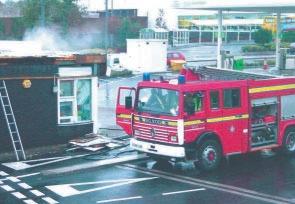
Smoking shop as fire engines arrive
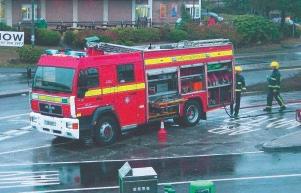
Site closed by Fire Brigade
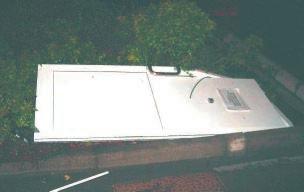
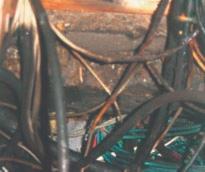
Scorched wires in electrical duct
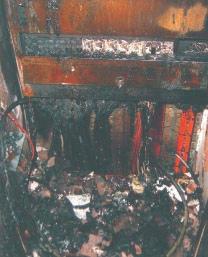
Burnt wires in Shop
Door blown 30 metres from shop
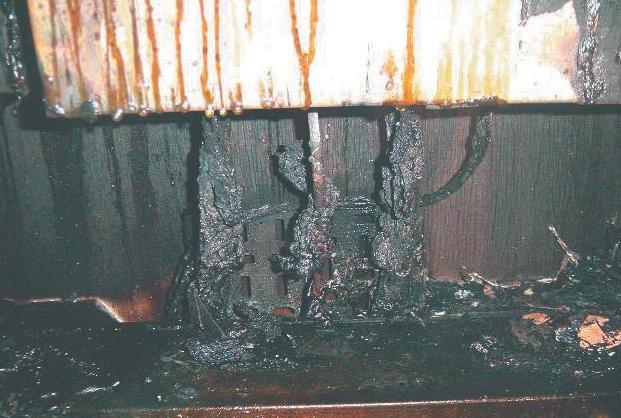
Explosion damange in shop
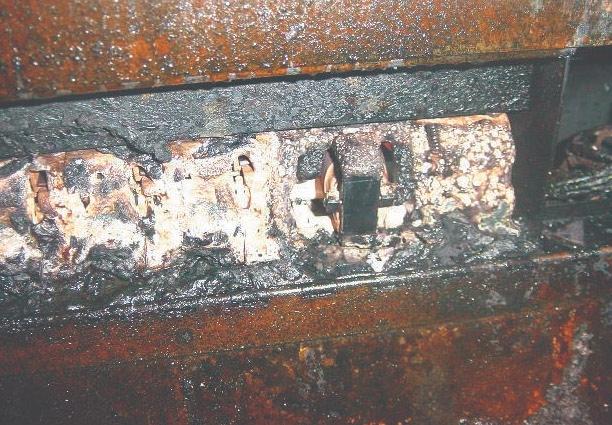
Explosion damange in shop
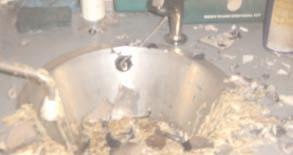
Explosion damange in shop
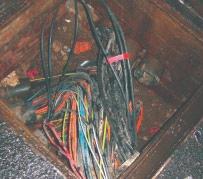
Unsealed electrical duct
The Blue Book
By Jamie Thompson
The APEAand the Energy Institute (formerly the Institute of Petroleum) have decided that after publication in 1999 the Blue Book is to be reviewed and updated.
Apart from a general update of standards referred to, there is a need to include some amendments on the electrical chapter and the canopy section in particular, and take the chance to update other sections as needed.
Both bodies are cooperating as before in ensuring that as wide an audience are consulted on the changes and the original Technical Coordinating Body (TCB) is being contacted to inform them of this work.
The group co-ordinating the review is being jointly chaired by Tony Jenner representing the APEA and Rory Hennessy representing AUKOI. Secretarial support is being provided by Martin Hunnybun of the Energy Institute.
Small groups of experts dealing with each of the 18 chapters in the book will carry out the review and report back to the main committee to ensure that all proposed amendments receive consensus. In addition to the UK stakeholders both bodies are anxious to ensure that as wide a consultation as possible is taken with overseas users of the Code. Many of the sales of the Blue book are going abroad and countries and oil companies have adopted this book as their engineering standard for constructing petrol stations.
If you have any comments on the Code or wish to contribute in any way please contact Jane Mardell the APEA business manager at admin@apea.org.uk The Blue Books correct title is Guidance for the Design, Construction, Modification and Maintenance of Petrol Filling Stations ISBN 0 85293 217 0
Bacteria For The Environment
By Harold Ross, Ross Environmental
Advertisements recommending regular changes of bodily bacteria are now accepted as a natural process for good health.
Why then shouldn't more of us accept bacteria as a means to guard the Environment from the damage of Oil Spills and the hazards associated with them.
At Ross Environmental Products we supply bacteria contained in absorbents,degreasers and tank bio cubes that eat the hydrocarbons contained in petroleum based products.
Major Military Camps, Local Authorities, Blue Chip companies and sole traders have already experienced the efficiency and effectiveness of our BIOREMEDIATION products.
Oil Spill hazards should be as extinct as the "Dodo" using Ross Eliminator absorbent. Not only is the spill absorbed virtually on contact but because of the process of BIOREMEDIATION- the bacteria eating the hydrocarbons in the spill,giving off a water vapour,some carbon dioxide and fatty acid-the "problem"is not transferred somewhere else or to someone else!
Key Features: • Very Fast-seconds to remove spill hazards
• Absorbs up to 8 times more than clay, therefore 8 times less to dispose of
• Recyclable in conjunction with a spill station
• Will not leach into the environment up to saturation point
• Safe around agriculture and livestock
• Contains Natural Micro-Organisms
• Reduces volatility of flammable spills
• Will absorb most chemicals
Thousands of businesses around Europe continue to defy legislation using a variety of products - rags, sawdust clay etc - which actually Enhance the Hazard and in most cases Increase Cost.
Ross Eliminator Absorbent takes literally seconds to remove spills of petrol, kerosene, diesel, jet fuels, metal working fluid, crude oil, black fuel oil, gas oil, hydraulic oil - leaving a non slip surface in most circumstances.
The absorbent contains millions of hydrocarbon eating microbes per bag which double every twenty minutes when active. Ross Eliminator Absorbent encapsulates and prevents leaching of contaminated liquids, up to saturation point. In simple terms the absorbent turns oil into water vapours,carbon dioxide and fatty acids. Bioremediation is the restoring of a surface or object to a condition that is not harmful to plant or animal life.
Futher proof of the increasing influence of Ross Environmental was the award of a "Green Apple Trophy"in the House of Commons on Nov 6th 2003.
However in all our considerations for the benefits to the Environment we cannot overlook cost.The absorbent is COST EFFECTIVE, is RECYCLABLE in conjunction with a Spill Station and IT REALLYDOES WORK.
Ross Environmental Products Ltd Telephone: Sales UK +(44) 01562 752299 Telephone: UK +(44) 01562 752400 Email: sales@rossenvironmental.co.uk web: www.rossenvironmental.co.uk
Articles Leak Locators - ADivision of PLATS Ltd
By Amanda M Kessell
LEAK LOCATORS is a division of PLATS Ltd that has been established since 1976. PLATS Ltd is able to offer the client a complete one stop solution as we are able to locate pipes, cables and drains and then present this information as a CAD Drawing. As our surveys got more detailed we were asked if we could find water leaks and that is how LEAK LOCATORS was born. This division has grown out of the need to find both Water and Fuel leaks that are underground.
We are able to offer two methods of finding Water Leaks either with a Leak Noise Correlater or with the H2 Gas Method, the Gas method is also used for finding Fuel Leaks. Both methods require us to locate the run of the pipe
and we are able to apply various methods of locating pipes, as well as plastic water pipes. Once the pipe is located we then mark its location on the surface. The Leak Noise Correlater method is able to listen for the leak using very sensitive transmitters with accelerometers that are attached to the pipework. Then we enter the size, type and length of pipe into the Correlator. The unit is then able to detect the leak in the pipe where there is a positive internal pressure, such that a leak causes a loss of fluid to the outside. The movement of the water causes pressure changes and this in turn a noise, this noise source will be where the leak is located. The correlator is able to detect this, and will produce a correlatorion showing the position from the to transmitters, which allows us to pin point the leak position. This method is used only for Water Leaks.
Generally LEAK LOCATORS are called onto the Forecourt once a line has been tested and failed, we recreate this test were possible with the fitter when we first attend site. We then work along side the fitter to establish the best position to insert the gas which can be either at the pump, tank top, Vent or Offset Fill via the BSPconnection.
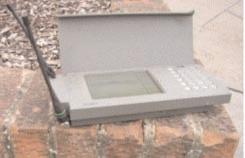
Correlator Unit
Gas in via pump
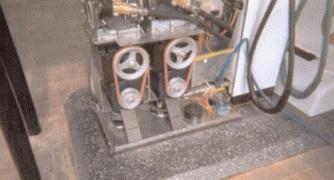
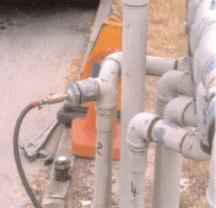
Gas in via Vent Gas in via tank
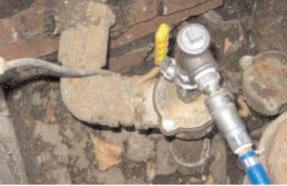
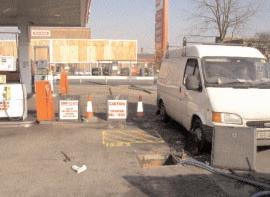
Hand Sensor
The gas method is used for both Water and Fuel leaks in any number of situations. The method of finding the leak is the same for Water and Fuel. First the pipe is located, and marked on the surface. The gas is then inserted into the pipe with a standard BSP connection and a manifold system in the vehicle. The gas is a low concentration of hydrogen gas - a combination of 5% Hydrogen in Nitrogen. The gas has been approved by the Drinking Water Inspectorate for use on the public supply. As the Hydrogen is one of the lightest and smallest molecules it is able to penetrate materials as dense as concrete and clay. The location of the leak then carried out by using the gas detector to locate where the gas is leaking, this unit only detects the Hydrogen as small as
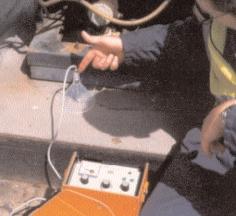
Site marked up ready to dig Sniffing with wheels
0.0001% in air. As the pipe is tested to a known test pressure we are able to "sniff" for the leak.
The gas detector has a number of devices attached from a hand sensor, set of wheels, a Ground Probe and Surface Probe. This method has proved to be very successful in many different situations, from Golf Courses, Heating Systems, Swimming Pools, Fire Mains as well as on the Forecourt to find fuel leaks.
Contact details:
Adam Foster or Amanda Kessell
Tel: 08700 11 5325 email@sales@leaklocators.net
Sniffing with pogo
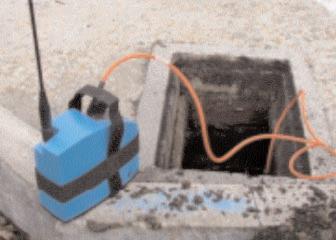
Transmitter





